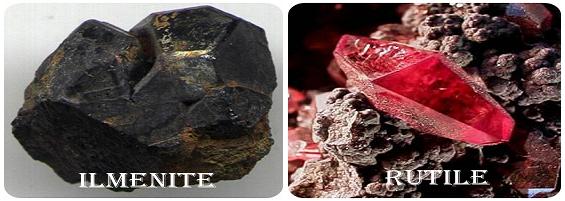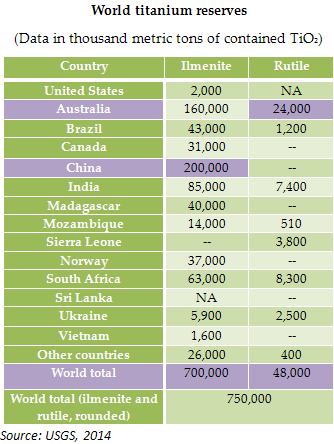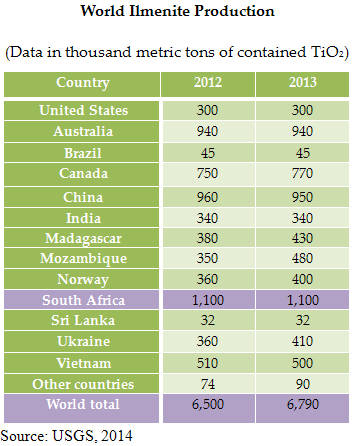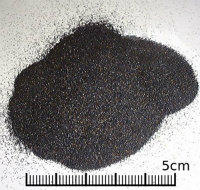- Titanium resources, reserves and production
- Titanium is present in the Earth’s crust at a level of about 0.6% and is therefore the fourth most abundant structural metal after aluminum, iron and magnesium. Titanium is always bonded to other elements in nature. It is present in most igneous rocks and in sediments derived from them (as well as in living things and natural bodies of water). Of the 801 types of igneous rocks analyzed by the United States Geological Survey (USGS), 784 contained titanium. Its proportion in soils is approximately 0.5 to 1.5%. It is widely distributed and occurs primarily in the minerals anatase, brookite, ilmenite, perovskite, rutile and titanite (sphene). The most important mineral sources are ilmenite (FeTiO3) and rutile (TiO2).

- Significant titanium-bearing ilmenite deposits exist in Western Australia, Canada, China, India, Mozambique, New Zealand, Norway, Ukraine and South Africa, while rutile deposits are found in South Africa, India and Sierra Leone.
- Major ilmenite deposit regions: eastern coast and western coast of Australia; Richards Bay in South Africa; eastern coast of America; Kerala in India; eastern coast and southern coast of Brazil.
- Major rutile deposit regions: eastern coast and western coast of Australia; southwest coast of Serra Leone; Richards Bay in South Africa, Canada, China and India’s minerals belong to titanium rock minerals, a primary mineral, featuring a lower grade of titanium concentrates, abundant reserves and concentrated producing areas. With higher grades of raw ore and scattered resource locations, titanium placer minerals mainly occur in Australia and the US. South Africa is abundant in both rock minerals and placer minerals.
- Rutile and ilmenite are extracted from sands that may contain only a few percent by weight of these minerals. After the valuable minerals are separated, the remaining sands are returned to the deposit and the land recultivated. In the United States, titanium-rich sands are mined in Florida and Virginia.
- Titanium is obtained from various ores that occur naturally on the Earth. Ilmenite (FeTiO3) and rutile (TiO2) are the most important sources of titanium.
- According to USGS, Ilmenite accounts for about 92% of the world’s consumption of titanium minerals. World resources of anatase, ilmenite and rutile total more than 2 billion tonnes. Identified reserves total 750 million tonnes (ilmenite plus rutile).
- From the table below, China, with 20 million tonnes--accounting for 29% of the world total-- is now the country that is most abundant in terms of ilmenite reserves. Meanwhile, Australia, with 24 million tones rutile reserves—accounting for 50% of the world total—is now the country that is most abundant in terms of rutile reserves.

- The total world reserves of ilmenite are around 700 million tonnes while rutile reserves are far less, numbering about 48 million tonnes.
- According to USGS, China has the world’s largest titanium reserves, with a total of 200 million tonnes identified to date, which make up 28.9% of the world total. Ilmenite is the principal source of titanium in China with rutile making up very little of the total.
- Around 108 mine fields across 21 provinces, autonomous regions and municipalities have found titanium resources, with Panxi in Sichuan, Chengdu in Hebe, along with others in Yunnan, Hainan, Guangxi and Guangdong the most prominent. Sichuan province is the foremost of these mining areas.
- Primary titanium ore and titanium placer deposits are of great importance to China. Panxi and Chengde have most of the nation’s total primary reserves.
- Titanium placer deposits are also distributed in Hainan, Yunnan, Guangdong and Guangxi provinces. Henan, Hubei and Shanxi provinces have limited rutile reserves.
- According to USGS, in 2013, the leading producers of titanium concentrates included South Africa (1.22 million tonnes), Australia (1.39 million tonnes), the US (300 thousand tonnes), China (950 thousand tonnes), Canada (770 thousand tonnes) and India (366 thousand tonnes).


- Even though the United States mines and processes titanium and titanium dioxide, it still imports significant amounts of both. Metallic titanium is imported from Russia (36%), Japan (36%), Kazakhstan (25%) and other nations (3%). TiO2 pigment for paint is imported from Canada (33%), Germany (12%), France (8%), Spain (6%) and other nations (36%).
 From the data above, we can see that China’s titanium concentrates are mainly extracted from ilmenite, with very little from rutile. In China, Sichuan province, Hainan and Hebei are the main titanium concentrates producers. Although titanium resources are abundant in China, the grade is not sufficient to produce high-grade titanium concentrates, which necessitates imports from countries like Australia, Vietnam and India. At present, Vietnam is China’s biggest source of imports.
From the data above, we can see that China’s titanium concentrates are mainly extracted from ilmenite, with very little from rutile. In China, Sichuan province, Hainan and Hebei are the main titanium concentrates producers. Although titanium resources are abundant in China, the grade is not sufficient to produce high-grade titanium concentrates, which necessitates imports from countries like Australia, Vietnam and India. At present, Vietnam is China’s biggest source of imports.
-
About us
Contact us
Make a suggestion
- Metalpedia is a non-profit website, aiming to broaden metal knowledge and provide extensive reference database to users. It provides users reliable information and knowledge to the greatest extent. If there is any copyright violation, please notify us through our contact details to delete such infringement content promptly.




 From the data above, we can see that China’s titanium concentrates are mainly extracted from ilmenite, with very little from rutile. In China, Sichuan province, Hainan and Hebei are the main titanium concentrates producers. Although titanium resources are abundant in China, the grade is not sufficient to produce high-grade titanium concentrates, which necessitates imports from countries like Australia, Vietnam and India. At present, Vietnam is China’s biggest source of imports.
From the data above, we can see that China’s titanium concentrates are mainly extracted from ilmenite, with very little from rutile. In China, Sichuan province, Hainan and Hebei are the main titanium concentrates producers. Although titanium resources are abundant in China, the grade is not sufficient to produce high-grade titanium concentrates, which necessitates imports from countries like Australia, Vietnam and India. At present, Vietnam is China’s biggest source of imports.